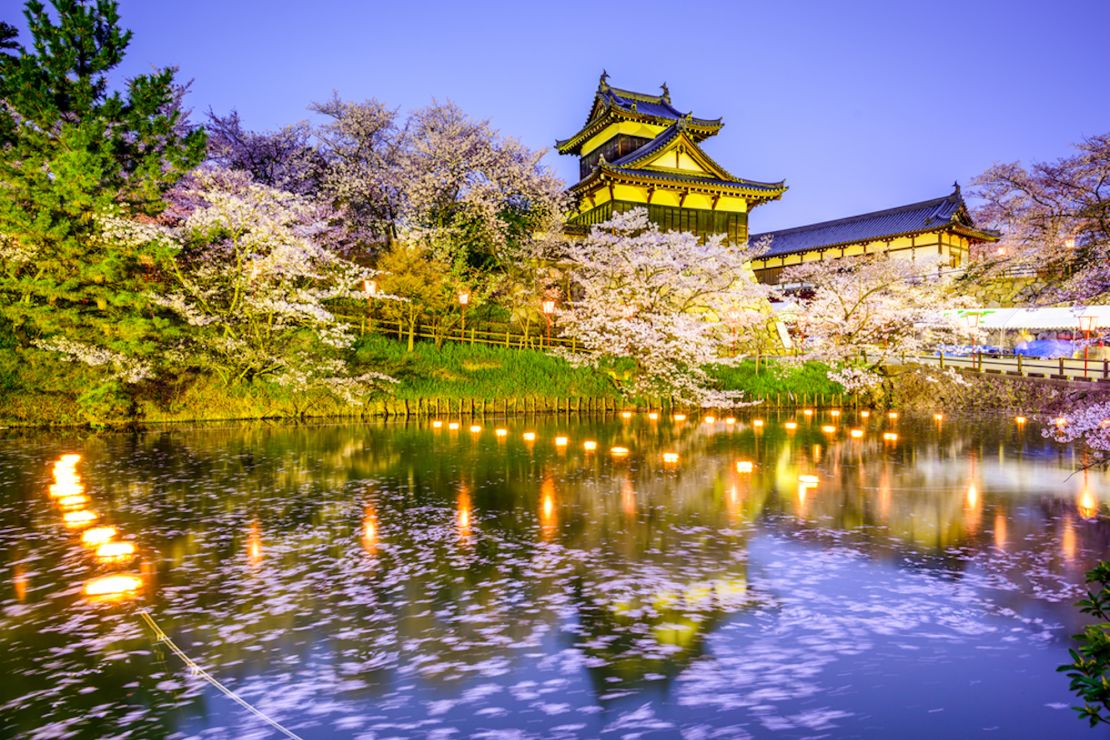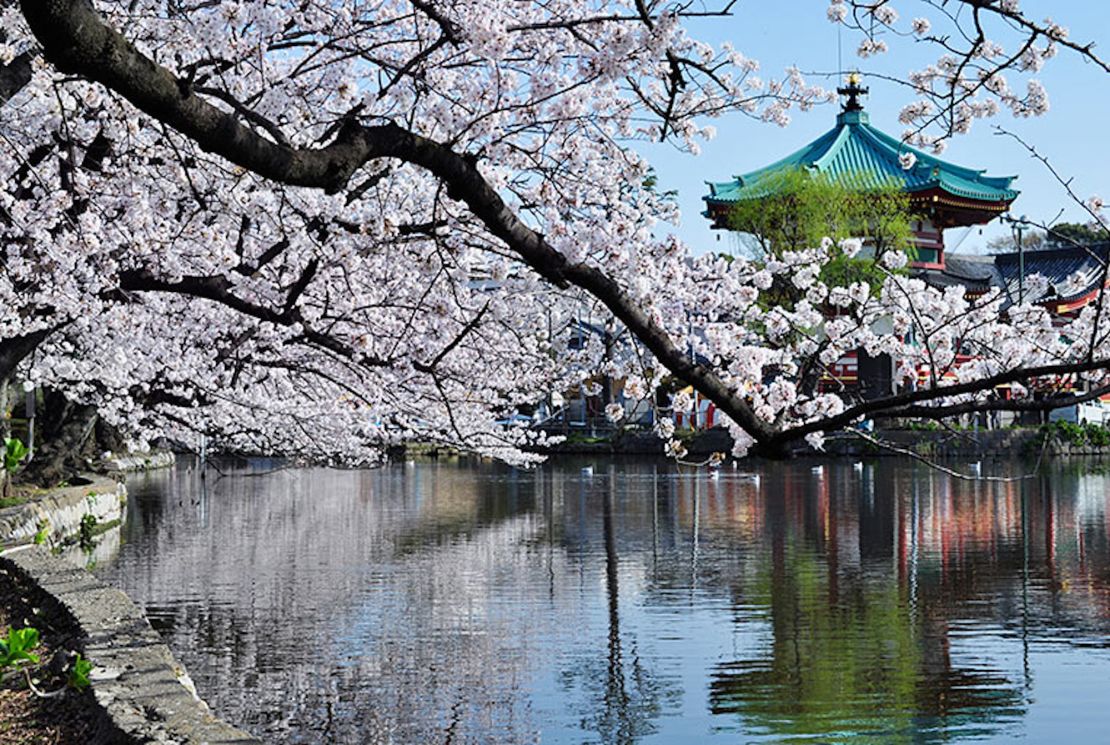For just a few weeks every spring, Japan celebrates an annual ritual known as hanami. In theory, it’s a simple pleasure: stopping to view and appreciate the beautiful spring blossoms, most commonly cherry trees.
In reality, it’s a hugely symbolic and much-loved source of national pride, a chance to recognize and reflect on the beauty of nature while welcoming the new season. People often gather and sit under the trees, bringing food, drinks and occasionally music with them. This being Japan, everything is perfectly organized and left spotlessly clean.
When the Japan Weather Association’s annual sakura forecast is broadcast live, it brings with it a flurry of domestic and international bookings as travelers rush to make the most of the country’s stunning landscapes and scenery.
Given the size and geographical spread of the country, the cherry blossoms – or sakura – appear at different times and usually only last for a few days. In January they’re already in bloom way down in Okinawa, but for the rest of the country, viewing times vary from late March until the second week of May.
According to the 2018 cherry blossom forecast, the blooms will likely appear in Kagoshima, on Kyushu island, on March 21. Tokyo will welcome the beautiful flowers on March 24. In the north, Sapporo will see sakura on May 2.
For a full list of predicted bloom times, visit JNTO.go.jp.
Here are some great destinations to experience this short but uniquely Japanese phenomenon.
Mount Fuji
World Expeditions runs a two-week “Backroads of Japan” tour that crosses the country during cherry blossom season and includes a visit to Japan’s most iconic natural wonder – and most famous active volcano – Mount Fuji.
The mountain is surrounded by five lakes – Lake Kawaguchi, Lake Yamanaka, Lake Sai, Lake Motosu and Lake Shoji – all of which provide the perfect foreground to appreciate the region’s cherry blossoms.
Given the mountain’s popularity and symbolic importance, the region can often be very busy. But thanks to the large number of viewing options you can almost always frame that perfect Japanese shot.
Kanazawa
Kanazawa is a beautifully preserved historic city on the coast near the Japanese Alps, a series of mountain ranges that bisect the country’s main island of Honshu.
It’s famed for its Kenrokuen Gardens, considered one of the top three gardens in the country – which is really saying something. It also features a small geisha community as well as a samurai district.
As it remains comparatively off the usual tourist radar, it allows for a particularly Japanese sakura experience.
Nara

The ancient capital of Nara sits a short train ride from Kyoto and makes for a popular day trip with its abundance of opportunities to catch cherry blossoms in all their glory.
In the Shinto religion deer are regarded as messengers of the gods, while they also serve as a symbol of the city. As a result deer roam throughout Nara, especially in “Deer Park” right in the center.
Nara also has one of the world’s largest wooden buildings in the form of the Buddhist Todaiji Temple, while Naramachi is a well preserved former merchant district.
Finally the Kasugataisha shrine, more than 1,200 years old, is yet another remarkable spot to see the sakura amongst the temple’s stone and bronze lanterns.
Jacada Travel includes it as a stop on its Cherry Blossom of Japan luxury tour.
Kyoto
The historic and beautiful former capital of Kyoto boasts 17 UNESCO World Heritage Sites and more than 1,600 temples, making it one of the most popular destinations for cherry blossom visitors.
Sakura trees line the banks of the serene Kamogawa River, while the city’s Imperial Palace has 60 sakura blossoms known as “Shidare,” which tend to bloom earlier than many spots in the city.
The Shinto Heian Shrine is another popular viewing point thanks to a large number of pink weeping cherry trees in the gardens and grounds.
But one of the most iconic spots can be found in the city’s Gion district, the ancient home to Japan’s geisha.
The Shirakawa waterway runs through a section of Gion near the river and is lined with trees that gently curve towards the water as their blossoms fall and get carried gently downstream. A number of small bars and restaurants line the water and feature terraces that afford some of the best views.
Meanwhile, in the west of the city sits Oharano Shrine. The unique blossoms here are known as “Sengan-sakura,” or “One thousand wishes,” as dreams are said to come true when lucky visitors catch the blossoms during the handful of days they’re in bloom.
A large pond, red bridge and ancient trees including a 450-year-old fir help make it the picture-perfect Japanese garden. The shrine itself is located in a 20-acre maple forest, meaning that the gently rolling hills again explode in color every fall.
Tokyo’s Ueno Park

Even in the vast metropolitan expanse of Tokyo there are multiple ways to enjoy sakura watching.
Most famous amongst them comes in the form of Ueno Park, which is lined with thousands of cherry trees. A popular destination at any time, in sakura season it truly comes into its own when a thousand lanterns illuminate the park.
With the spectacle come huge numbers of visitors, so space underneath the pale pink Yoshino cherry trees is coveted. This means you’ll need to grab a special hanami bento box from one of the city’s legendary department stores and get there early to reserve your space with a picnic sheet.
Special events and an antique market are among the other attractions for those who don’t get to secure one of the most sought-after spots.
Niseko
Japan’s northernmost island of Hokkaido offers some of the country’s wildest and most remote landscapes, but it’s a more manicured environment near Niseko that provides an unusual way to enjoy sakura: a round of golf.
One of the two courses at Niseko Village was designed by the legendary Arnold Palmer and features sakura trees along fairways and at the clubhouse entrance to welcome players. Views toward one of Japan’s most sacred mountains, the snow-capped Mt. Yotei, add to the unique sporting experience.
Given Niseko’s location, mid May is the best time to catch the blooms in their glory.
Goryokaku Park, Hakodate
The view from the Goryokaku Tower in the city of Hakodate in southern Hokkaido offers the ultimate aerial cherry blossom experience.
The tower overlooks Fort Goryokaku, a huge star-shaped citadel built in 1855 that lost its importance and subsequently became a public park in 1910.
As part of the transformation, more than 1,000 cherry trees were planted, including hundreds along its former defensive moats, ensuring it remains one of Japan’s most unusual and remarkable spots to catch the short-lived sakura in all their glory.
Japan's 36 most beautiful places
Chris Dwyer is a Hong Kong-based food and travel writer and communications consultant. Follow him on Twitter at @chrismdwyer or visit www.finefooddude.com.













































